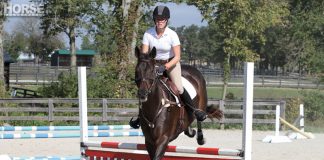Q. What exercises can I do to get my harness horse driving from his hind end?
Thinking of how a slinky works might help you visualize how you want your horse to move. If you push on the back end of the slinky and let all the tensile energy out the front end, the front end just drops onto the floor, right? Then again, if you pull on the front end without holding up the back end, the back end drops onto the floor. But if you squeeze both ends together, the slinky springs in the middle. Well, that’s what you want the horse to do. You want him to have the tensile strength of a coiled spring, to use his back in a springy relaxed manner and to increase the bend and action of his leg joints. You want his body to go from a football or oval shape to a more rounded shape. You do this by increasing the drive from behind and “resisting” the forward movement with your hands. You can’t achieve this quickly. The horse has to build the muscle he needs to carry himself in this more active way, so take it slowly. This is like body building for horses, and you won’t achieve anything except a sore horse if you take it too fast.
Trot transitions are a great exercise to use for beginning to get a horse to work off his hind end more. Start at a working trot, then ask for a lengthened trot but don’t give much rein. Just ask your horse to go forward onto your hands for a few strides and then bring him back to the working trot. Keep doing that sequence around your ring, or down the road. Hills are a great place to ask for a lengthened trot as the horse has to use his back end to get up the hill. Try not to let all the energy out the front door (think of the slinky), but don’t crank back on your reins, either.
When your horse is doing a good lengthened trot, you can start adding in a bit of collected trot.
A collected trot shouldn’t have a slower tempo, just cover less ground. But it needs more energy to achieve this.
Remember the slinky!
Push your horse forward but hold his forward energy in your hands. This should help you get your horse to round his back, engage his hind end, and be in a much rounder position. (Think of squishing the slinky together.) But don’t lose the forward energy. Do a few strides of collected trot, and then go back to working trot as the collected trot takes great strength for the driving horse to do.
You can then alternate between the working trot, lengthened trot and collected trot to achieve more action in the hind end.
Remember, your horse must be attentive, soft on the aids, and willing at all times. If there is any resistance on his part, something is wrong so go back to his comfort zone and try to figure out what is causing his resistance. The bit should never be a “barrier” in the horse’s mouth. So if you feel you’re “blocking” his forward movement, lighten a little and use half-halts to collect him instead of pulling back constantly.
Also remember that any kind of progression in training takes time. Try not to belabor any one point in any session or you’ll get a sore and resentful horse. Take your time and enjoy the journey!
Learn more about driving expert Muffy Seaton >>






Excellent information. I’d read about these iads before, but their true purpose was never explained vis a vis driving, so clearly. Looking forward to more words of wisdom from Muffy.
What a great article!!